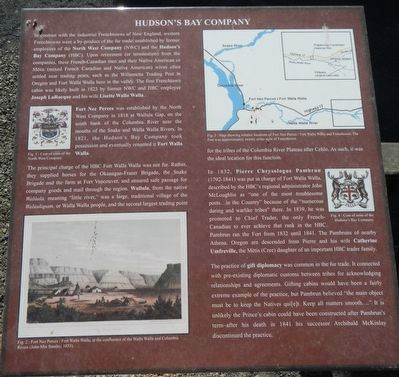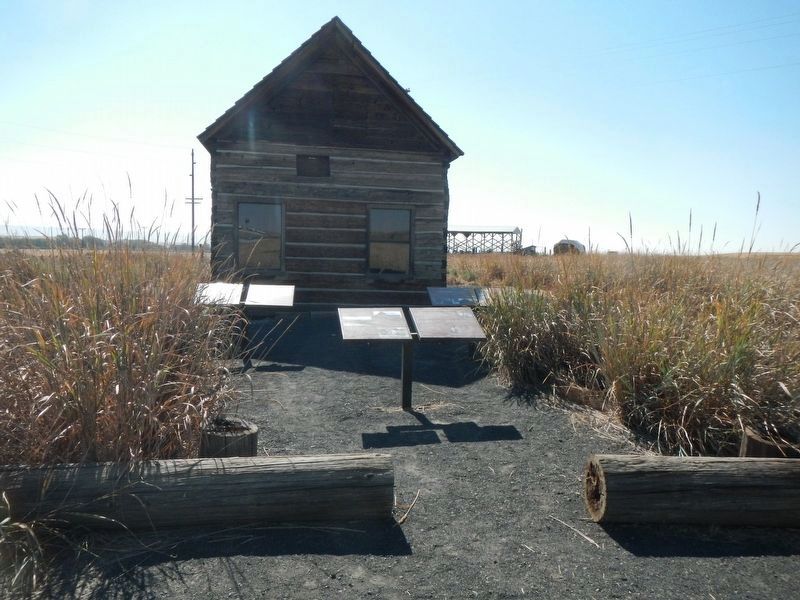Near Walla Walla in Walla Walla County, Washington — The American West (Northwest)
Hudson's Bay Company

Photographed By Barry Swackhamer, August 14, 2020
1. Hudson's Bay Company Marker
Captions: Fig. 1: Coat of arms of the North West Company.; Fig. 2: Fort Nez Perce/Fort Walla Walla, at the confluence of the Walla Wall and Columbia Rivers (John Mix Stanley, 1853).; Fig. 3: Map showing relative locations of Fort Nez Perce/Fort Walla Walla and Frenchtown. The Fort was approximately twenty miles west of Frenchtown.; Fig. 4: Coat of arms of the Hudson's Bay Company.
Fort Nez Perce was established by the North West Company in 1818 at Wallula Gap, on the south bank of the Columbia River near the mouths of the Snake and Walla Walla Rivers. In 1821, the Hudson's Bay Company took possession and eventually renamed it Fort Walla Walla.
The principal charge of the HBC Fort Walla Walla was not fur. Rather, they supplied horses for the Okanagan-Fraser Brigade, the Snake Brigade and the farm at Fort Vancouver, and ensured safe passage for company goods and mail through the region. Wallula, from the native Walúula, meaning "little river,' was a large traditional village of the Walúulapam, or Walla Walla people, and the second largest trading point for the tribes of the Columbia River Plateau after Celilo. As such, it was the ideal location for this function.
In 1832, Pierre Chrysologue Pambrun (1792-1841) was put in charge of Fort Walla Walla, described by HBC's regional administrator John McLoughlin as "one of the most troublesome post...in the Country" because of the "numerous daring and warlike tribes" there. In 1839, he was promoted to Chief Trader, the only French-Canadian to ever achieve that rank in the HBC. Pambrun ran the Fort from 1832 until 1841. The Pambruns of nearby Athena, Oregon are descended from Pierre and his wife Catherine Umfreville, the Métis (Cree) daughter of an important HBC trader family.
The practice of gift diplomacy was common in the fur trade. It connected with pre-existing diplomatic customs between tribes for acknowledging relationships and agreements. Gifting cabins would have been a fairly extreme example of the practice, but Pambrun believed "the main object must be to keep the Natives qui(e)t. Keep all matters smooth...." It is unlikely the Prince's cabin could have been constructed after Pambrun's term-after his death in 1841 his successor Archibald McKinlay discontinued the practice.
Erected 2016 by Frenchtown Historical Foundation.
Topics. This historical marker
is listed in these topic lists: Industry & Commerce • Native Americans.
Location. 46° 2.991′ N, 118° 30.725′ W. Marker is near Walla Walla, Washington, in Walla Walla County. Marker can be reached from Old Highway 12 near U.S. 12, on the left when traveling east. The marker and cabin are located near the Frenchtown Historical Foundation kiosk. Touch for map. Marker is at or near this postal address: 8519 Old Highway 12, Walla Walla WA 99362, United States of America. Touch for directions.
Other nearby markers. At least 8 other markers are within walking distance of this marker. Welcome to the Prince's Cabin (here, next to this marker); The Prince (here, next to this marker); French-Canadian Cabin Design (here, next to this marker); St. Rose Mission (about 700 feet away, measured in a direct line); Local Tribes (approx. 0.2 miles away); Frenchtown (approx. 0.2 miles away); The Battle of Walla Walla (approx. 0.2 miles away); Saint Rose Mission (approx. 0.2 miles away). Touch for a list and map of all markers in Walla Walla.
Credits. This page was last revised on October 28, 2020. It was originally submitted on October 28, 2020, by Barry Swackhamer of Brentwood, California. This page has been viewed 222 times since then and 21 times this year. Photos: 1, 2. submitted on October 28, 2020, by Barry Swackhamer of Brentwood, California.
